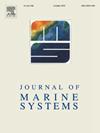Seasonal patterns of microbial plankton and periodicity of climatic and hydrographic conditions in a semi-desert macrotidal wetland
IF 2.5
3区 地球科学
Q2 GEOSCIENCES, MULTIDISCIPLINARY
引用次数: 0
Abstract
Macrotidal wetlands of temperate areas are highly productive systems where interactions between land and water are particularly dynamic. Typically, these systems display temporal shifts in their water properties not only because of annual fluctuations in the photoperiod and air temperature but also due to strong tidal regimes and climatic events. In contrast with the well-studied microtidal systems, the temporal fluctuations in structure and biomass of microbial communities of semi-desert, enclosed temperate macrotidal wetlands are scarcely known, and thus the coupling between primary producers and the bacterial community occurring within them remains poorly understood. In this study we analyze the fluctuations of unicellular plankton and hydrographic conditions on a fixed station located in San Antonio Bay (SAB, Northern Argentine Patagonia) from spring 2016 to early summer 2018 with the aim of detecting possible associations with the periodicity of some climatological variables and local meteorological events. Density and biomass of microbial size fractions (pico-, nano- and microplankton) along with their nutrition modes (autotrophic, potentially mixotrophic and heterotrophic) were assessed based on bi-weekly samplings. In addition, the study also examines the relationships of autotrophs and bacterioplankton with the frequency, duration, and magnitude of phytoplanktonic blooms, as well as the biomass contribution of dominant diatom species. We found a microbial-dominated planktonic system with increased densities of both autotrophic and heterotrophic picoplankton and flagellated protists. The biomass of potentially mixotrophs dominated over that of autotrophs and heterotrophs along the entire period. Autotrophic biomass showed a single annual maximum in summer, while chlorophyll-a displayed a biannual cycle. Neither chlorophyll-a nor autotrophic biomass reached high values as compared to other coastal systems with no clear dominant phytoplanktonic taxa. The annual phytoplanktonic biomass cycle in SAB appears not to be related to those of other coastal environments from North Patagonia. We infer that the strong macrotidal dynamics limits primary production and turns this system into a high nutrient/low chlorophyll one that exports surplus nutrients in tide-driven pulses to neighboring areas.
半荒漠潮间带湿地微生物浮游生物的季节模式与气候和水文条件的周期性
温带地区的大潮湿地是一种高产系统,其中土地和水之间的相互作用特别动态。通常,这些系统的水性质会随时间变化,这不仅是因为光周期和气温的年度波动,还因为强烈的潮汐和气候事件。与研究充分的微潮系统相比,半沙漠、封闭温带大潮湿地微生物群落结构和生物量的时间波动几乎不为人所知,因此对初级生产者与其中发生的细菌群落之间的耦合仍然知之甚少。在这项研究中,我们分析了2016年春季至2018年初夏位于阿根廷北部巴塔哥尼亚圣安东尼奥湾(SAB, Northern argentina Patagonia)的一个固定站的单细胞浮游生物和水文条件的波动,目的是发现一些气候变量和当地气象事件的周期性可能存在的关联。以双周采样为基础,评估了微生物大小组分(微型、纳米和微型浮游生物)的密度和生物量及其营养模式(自养、潜在混合营养和异养)。此外,本研究还探讨了自养生物和浮游细菌与浮游植物华的频率、持续时间和规模以及优势硅藻物种的生物量贡献的关系。我们发现了一个微生物主导的浮游生物系统,自养和异养微浮游生物和鞭毛原生生物的密度都增加了。在整个过程中,潜在混合营养体的生物量高于自养和异养生物。自养生物量在夏季表现为单年最大,而叶绿素-a则表现为双年最大。与没有明显优势浮游植物类群的其他沿海系统相比,叶绿素-a和自养生物量均不高。SAB的年浮游植物生物量循环似乎与北巴塔哥尼亚其他沿海环境无关。我们推断,强烈的大潮汐动力学限制了初级生产,使该系统成为高营养/低叶绿素系统,并以潮汐驱动的脉冲向邻近地区输出多余的营养物质。
本文章由计算机程序翻译,如有差异,请以英文原文为准。
求助全文
约1分钟内获得全文
求助全文
来源期刊

Journal of Marine Systems
地学-地球科学综合
CiteScore
6.20
自引率
3.60%
发文量
81
审稿时长
6 months
期刊介绍:
The Journal of Marine Systems provides a medium for interdisciplinary exchange between physical, chemical and biological oceanographers and marine geologists. The journal welcomes original research papers and review articles. Preference will be given to interdisciplinary approaches to marine systems.
 求助内容:
求助内容: 应助结果提醒方式:
应助结果提醒方式:


